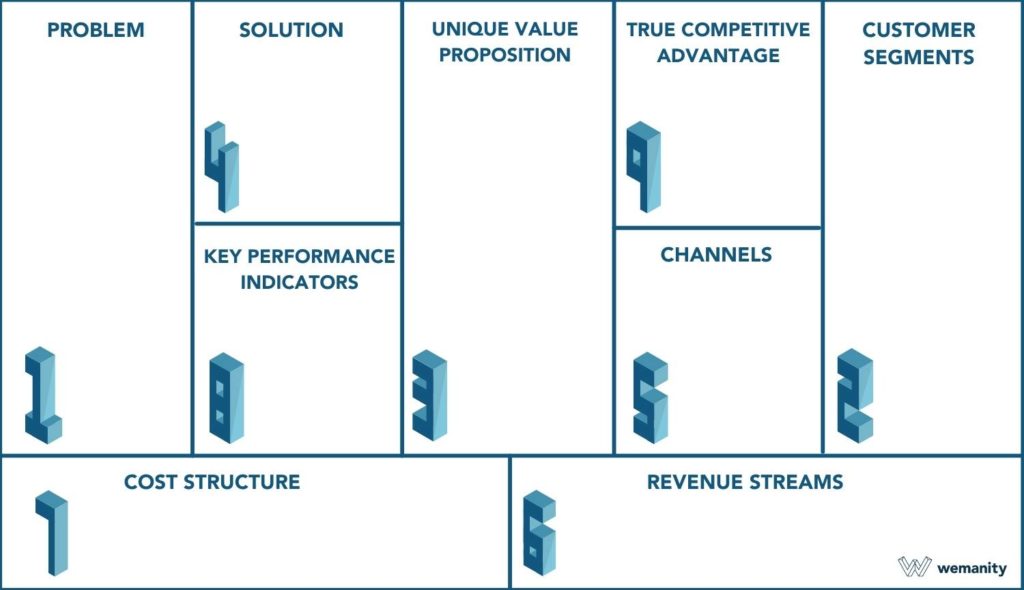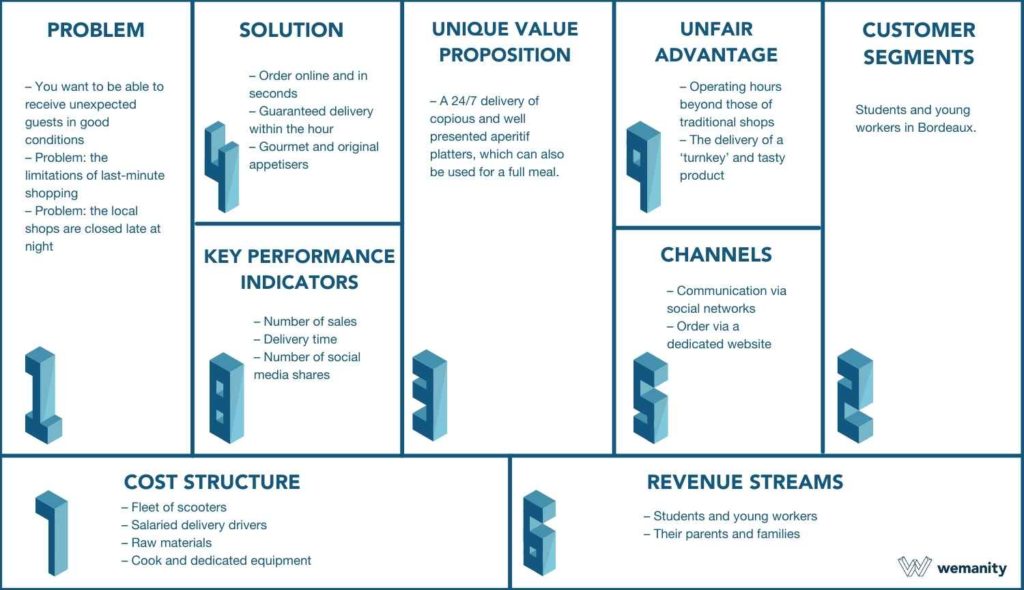What is the point of mobilising resources to design a product or service if it does not meet your target expectation? Even before the first market study, a brief brainstorming session around a Lean Canvas will allow you to define the first outlines of your project.
Formalisation of the economic model, identification of the customer and your indicators, testing of various hypotheses, and more … We will reveal everything about this innovative and eminently pragmatic approach, stemming from the philosophy of Lean Startup.
1. Lean Canvas: what is it?
The Lean Canvas is a tool that may surprise at first glance by its very basic appearance. It takes the form of a table made up of ten boxes. Each compartment corresponds to one of the fundamental questions typically posed by an entrepreneur or a project leader:
- Who is your product or service for?
- What is its added value?
- How does it allow the customer to solve a problem or satisfy a need?
- What are the costs to take into account?
- What aspect will mark your product or service out from the competition?
- What are the possible distribution channels for your offer?
- What are the key performance indicators to remember?
- Etc

In just a few minutes, it is possible to lay the foundations of your business plan, formalise its main characteristics and identify any weaknesses. The Lean Canvas is thus an excellent tool in the service of a business agility strategy.
Today, there are several variations of Lean Canvas. However, all of them are based on the principles of Lean Startup, conceptualised by the American entrepreneur and blogger Eric Ries in 2011 in his seminal book The Lean Startup.
What is ‘Lean Startup’?
Lean Startup aims to test a business idea easily and quickly, minimising risk taking and the associated costs. It values a pragmatic and empirical approach to understand the real expectations of the consumer, via a permanent exchange with a small panel of users.
2. Why use the Lean Canvas?
The Lean Canvas model is particularly suited to a start-up seeking to innovate and create a new segment of products or services. In this case, in fact, it is impossible to base yourself on the state of the existing market or on the economic model of your main competitors. The Lean Canvas then allows you to engage in a real iterative process of ‘trial and error’. All you need to do is:
- Carry out a first draft of the canvas, by laying down on the paper the main characteristics of the project as you visualise it;
- Carry out a series of meetings and interviews with a sample of the target clientele: it is important not to offer your solution straight away, but to listen carefully to the client’s needs and difficulties;
- Correct your outline if the answers given do not match the solution initially adopted;
- Submit your idea during new meetings, and to assess the interest it arouses.
As part of a more traditional entrepreneurial approach, in an already well-consolidated market, this approach will not always be the most useful or relevant. It is therefore better to opt for a Business Model Canvas, with a more general purpose.
What is the difference between Lean Canvas and Business Model Canvas?
Lean Canvas is actually an adaptation of an earlier model, the ‘Business Model Canvas’ designed by Alexander Osterwalder and Yves Pigneur. In a comparable format, the Business Model Canvas has some specificities:
- The ‘Problems’ box is replaced by that of the project’s ‘Partners’;
- The ‘Solutions’ box disappears in favour of your company’s ‘Key Activities’;
- The ‘Indicators’ box leaves room for ‘Key Resources’ to be mobilised;
- The ‘Competitive Advantages’ box is renamed ‘Customer Relations’.
3. How to complete your Lean Canvas?
The first step is to print a blank Lean Canvas template, preferably in a large format like A3. This will give you all the space you need to transcribe your thoughts or stick on a multitude of Post-it notes! If several creators wish to join the project, it is in your interest to make it a collective exercise in the form of a brainstorming session.
Dedicated management tools will also allow you to work directly on a scanned document and to share it. Miro or Klaxoon are of particular note here due to their well-thought-out interface and could make your job easier.
In order to organise your ideas well and lead the reflection, it is recommended to carefully fill in the boxes of the table in the order suggested below:
- The problem to be solved: the main difficulty or frustration experienced by the customer, and their possible motivation to make a purchase
- The customer segment: the typical profile or ‘persona’ of the customer targeted by the product or service offer
- The unique value proposition: the added value of your offer compared to the competition and to already existing comparable services
- The solution: the main selling points that might appeal to the target customer and convince them to buy
- The channels: the various vectors envisaged for the promotion and marketing of the offer (website, ‘hard’ store, creation of an Instagram community, etc.)
- Sources of revenue: the exact origin of expected revenue, taking care to differentiate, if necessary, the user (the one consuming your product or service), the customer (the one who pays) and the prescriber (the one recommending the solution)
- The cost structure: the main fixed and variable costs induced by the exercise of the activity and the marketing of the offer
- Key performance indicators: the metric used to measure the success of the new commercial offer and its adequacy to customer expectations
Our three tips for a successful Lean Canvas
Lean Canvas only reveals its full potential when it is carried out under the right conditions! These few tips will help you use the Lean method wisely.
1 – Organise a brainstorming session
Ideas flow more easily in a group and in a collaborative leadership environment. Organising a brainstorming session is the best way to come up with a rough outline. Brainstorming can also provide valuable information and unfiltered initial feedback from potential customers.
The experience will be all the more enlightening if you carefully prepare for the session and follow these 12 commandments for a successful meeting.
2 – Validate your working hypotheses
The Lean Canvas is also an exercise in foresight, consisting in making projections and making assumptions. It is of course recommended to stick to a certain realism in the statement of your objectives, your indicators or the added value of your solution. Then think about validating your hypotheses by going to meet your customers, or by developing a prototype. To form a cohesive business model, the information in your matrix must be proven and real.
3 – Adapt the model to your project
Lean Canvas is not an all-encompassing model. Some particularly complex or original projects may require modification of the table. In other cases, the creation of a different canvas per customer segment may be considered.
You will be able to push your reflection further concerning the nature of the problems and the needs of your customers, but also to refine your solution for each targeted category.
The table below represents a fictitious example of Lean Canvas, concerning the delivery of aperitif trays to homes in the city centre of Bordeaux. The model used is the one recommended by the Indian entrepreneur Ash Maurya:

The Lean Canvas is of course only a first draft of your innovative entrepreneurial project. However, it has the advantage of asking all the right questions at the start of your reflection, and will often prevent you from taking the wrong path. Based on the pragmatic approach of Lean Startup, this enlightening exercise allows you to check the validity of your idea inexpensively, without taking an ill-considered risk.
Wemanity can advise and support you to put the strength of Agile, cooperation and innovation at the service of your project. Get in touch!
The three key points to remember:
- The Lean Canvas is a table template intended to define the first outlines of your business plan.
- It addresses all the aspects vital for the viability of your project: target customers, added value, fixed costs, competitive advantage, etc.
- Its assumptions can be revised and refined based on the initial feedback from your market research.












